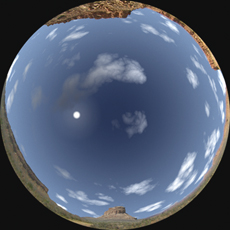 Dan Spence
Dan SpenceIn the fall of 2005, Northern Kentucky University students will finally get the chance to gaze up at a Martian sky or stand on the sun and watch the planets orbit.
Though that may sound impossible, NKU will soon be home to a new $1.2 million, state-of-the-art, digital planetarium which can simulate various scenarios.
This particular planetarium’s digital technology allows students to see motion from different points in space and from different planets than earth.
“That’s one thing that is special about this planetarium,” said Dan Spence, NKU’s planetarium coordinator. “Planetariums for years have been able to project stars and show some motion on the dome, but this planetarium can actually place the viewer at any point in that.
“So you could be out in space and be part of that motion. So you could sit on the sun and watch the planets go around, or you could land on the surface of Mars and see Mars around you and the moons overhead.”
Because the planetarium is digital it also has other benefits. “Basically anything you can draw on a computer screen, it projects on a dome,” Spence said.
This means “the state-of-the-art video planetarium/classroom will be capable of projecting not only stars, planets, constellations, and galaxies, but also video from NASA space missions, rendered artwork, streaming web content, and virtually any video source available,” according to the Northern Kentucky Chamber of Commerce’s Federal Agenda Infrastructure Investments 2002 report.
The primary function of the planetarium is to provide astronomy students with a visible representation of the concepts being taught to them. “It is really difficult to explain some concepts, some of the motions that occur in space, and it’s a lot easier to do if you can place a student in that environment,” Spence said.
Though, according to the NKCC report, the facility will offer other uses as well.
“This facility will also include geology uses (drifting continents projected on the dome), biology (a tour through a beating heart), chemistry (molecules interacting), or any scientific or mathematical material that can be displayed as a high-resolution image or modeled in computer graphics.”
The planetarium will also run multiple shows, the first entitled “Imagination Art and Science.” Spence said the show will include “a brief history of science since the beginning of time – through people’s experiences and their imaginations.”
“We will actually take people to the various places,” Spence said. “We have some sections done now of being in a primordial forest and also being in Chaco Canyon, New Mexico and being able to see the surroundings out there and where the Indians were actually learning to study the sky. We’ll actually take you there and show you what its like.”
Spence is also working on integrating real images into the digital projection to make the planetarium experience unique.
“Whenever possible, the actual places like the rocks or mountains will be the real thing superimposed into the computer graphics, so it won’t just be… like video games, it will be more real,” Spence said.
The planetarium will also house a community outreach program where local students will be able to come in experience planetarium and the shows.
Construction starts in May, and it is hoped that it will be finished by the fall of 2005.

